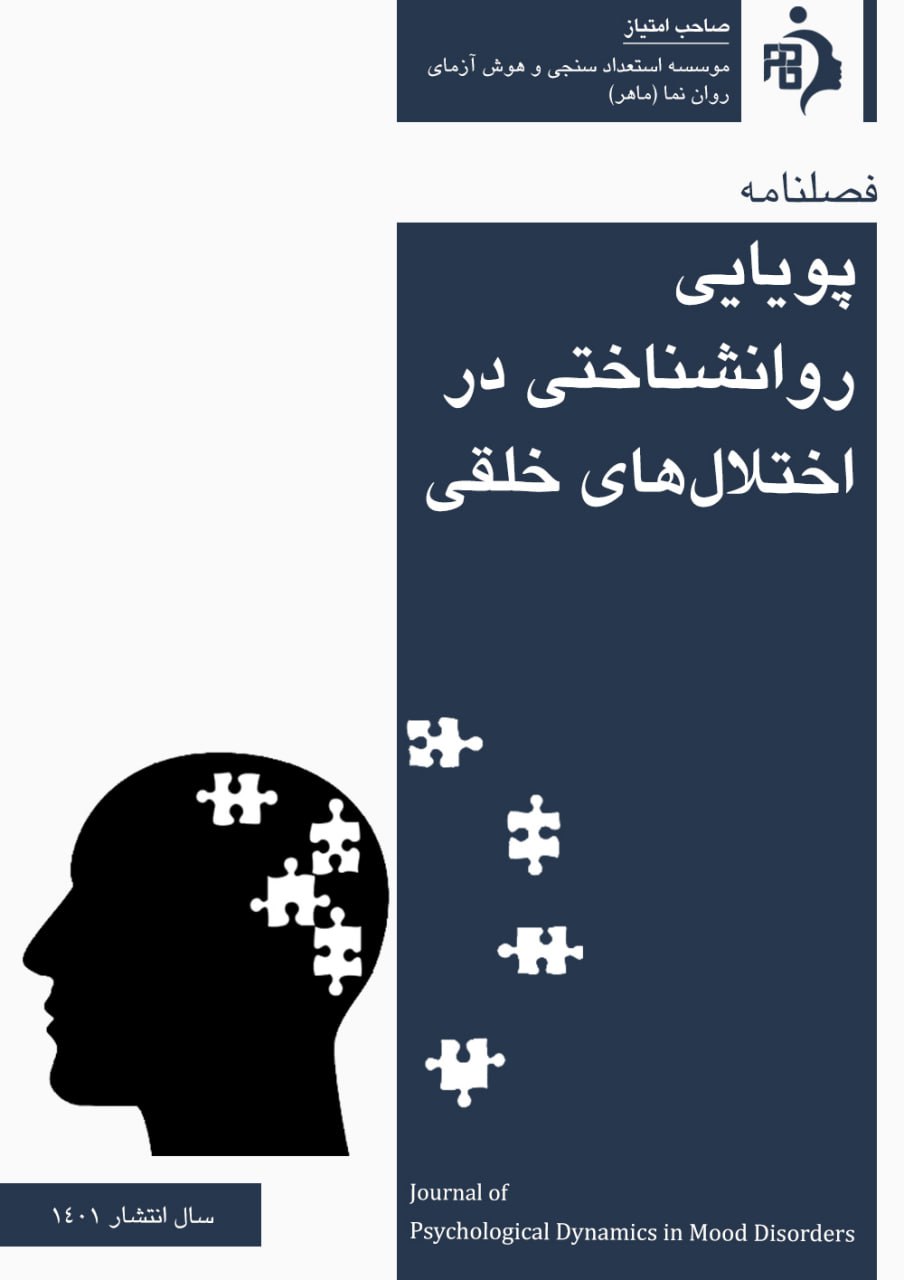Effectiveness of Designed Educational Content for Drug-Related Offenders in Ghezel Hesar Prison on Their Mental Health
Keywords:
Mental health, educational content, drug-related offendersAbstract
Objective: The present study aimed to evaluate the effectiveness of educational content specifically designed for drug-related offenders in Ghezel Hesar Prison on their mental health.
Methodology: This research is applied in terms of its objective and is quasi-experimental in terms of data type, utilizing a pre-test and post-test design with a control group. The statistical population included all individuals convicted of drug-related offenses in Ghezel Hesar Prison, from which 30 participants were selected as the sample size through convenience sampling. The data collection tool was the standardized Goldberg Mental Health Questionnaire (1972). To calculate validity, content validity was used, and to calculate reliability, Cronbach's alpha coefficients were employed, with the results indicating the validity and reliability of the instruments. Data analysis methods included descriptive and inferential statistics (analysis of covariance and one-sample t-test) using SPSS-V23 software.
Findings: The findings demonstrated that the designed educational package is effective in improving the mental health of drug-related offenders in Ghezel Hesar Prison. Thus, the designed educational content enables drug-related offenders to have a broader and more appropriate behavioral repertoire when confronting situations, allowing them to respond to issues with planning and foresight.
Conclusion: Therefore, using the designed psychological interventions can reduce the psychological problems of prisoners and prevent their recidivism.
Downloads
References
Acevedo, A., Garnick, D. W., Dunigan, R., Horgan, C. M., Ritter, G., Lee, M. T., Panas, L., Campbell, K. P., Haberlin, K., Lambert-Wacey, D., Leeper, T., Reynolds, M. A., & Wright, D. (2015). Performance Measures and Racial/Ethnic Disparities in the Treatment of Substance Use Disorders. Journal of Studies on Alcohol and Drugs, 76(1), 57-67. https://doi.org/10.15288/jsad.76.1.57
Baramake, Z., Fadavi, M. S., & Yousefi, Z. (2024). Development of a Successful Intelligence Training Package Aimed at Reducing High-Risk Behaviors Especially for Teenagers. Journal of Psychological Dynamics in Mood Disorders (PDMD), 2(4), 101-114. https://doi.org/10.22034/pdmd.2024.444922.1054
Barringer, A., Hunter, B. A., Salina, D., & Jason, L. A. (2016). Empowerment and Social Support: Implications for Practice and Programming Among Minority Women With Substance Abuse and Criminal Justice Histories. The Journal of Behavioral Health Services & Research, 44(1), 75-88. https://doi.org/10.1007/s11414-016-9499-6
Batastini, A. B., King, C., Morgan, R. D., & McDaniel, B. (2016). Telepsychological Services With Criminal Justice and Substance Abuse Clients: A Systematic Review and Meta-Analysis. Psychological Services, 13(1), 20-30. https://doi.org/10.1037/ser0000042
Bechelli, M. J., Caudy, M. S., Gardner, T. M., Huber, A., Mancuso, D., Samuels, P., Shah, T., & Venters, H. (2014). Case Studies From Three States: Breaking Down Silos Between Health Care and Criminal Justice. Health Affairs, 33(3), 474-481. https://doi.org/10.1377/hlthaff.2013.1190
Belenko, S., Hiller, M. L., & Hamilton, L. (2013). Treating Substance Use Disorders in the Criminal Justice System. Current psychiatry reports, 15(11). https://doi.org/10.1007/s11920-013-0414-z
Bellair, P. E., Vuolo, M., & LaPlant, E. G. (2017). Frequent Drug Use and Negative Employment Outcomes Among the Criminally Active. Substance Use & Misuse, 53(5), 828-836. https://doi.org/10.1080/10826084.2017.1388260
Callahan, S., Jason, L. A., & Robinson, L. (2016). Reducing Economic Disparities for Female Offenders: The Oxford House Model. Alcoholism Treatment Quarterly, 34(3), 292-302. https://doi.org/10.1080/07347324.2016.1182814
Clark, C. B., Hendricks, P. S., Brown, A., & Cropsey, K. L. (2014). Anxiety and Suicidal Ideation Predict Successful Completion of Substance Abuse Treatment in a Criminal Justice Sample. Substance Use & Misuse, 49(7), 836-841. https://doi.org/10.3109/10826084.2014.880722
Clark, C. B., Reiland, S., Armstrong, J., Ewy, R. B., & Cropsey, K. L. (2019). Characteristics Associated With a History of Physical and Sexual Abuse in a Community Corrections Sample. Substance Use & Misuse, 55(3), 512-518. https://doi.org/10.1080/10826084.2019.1686023
Clark, C. B., Reiland, S., Thorne, C. B., & Cropsey, K. L. (2013). Relationship of Trauma Exposure and Substance Abuse to Self-Reported Violence Among Men and Women in Substance Abuse Treatment. Journal of interpersonal violence, 29(8), 1514-1530. https://doi.org/10.1177/0886260513507138
Cook, B. L., & Alegrı́a, M. (2011). Racial-Ethnic Disparities in Substance Abuse Treatment: The Role of Criminal History and Socioeconomic Status. Psychiatric Services, 62(11), 1273-1281. https://doi.org/10.1176/ps.62.11.pss6211_1273
Cropsey, K. L., Binswanger, I. A., Clark, C. B., & Taxman, F. S. (2012). The Unmet Medical Needs of Correctional Populations in the United States. Journal of the National Medical Association, 104(11-12), 487-492. https://doi.org/10.1016/s0027-9684(15)30214-5
DeFulio, A., Stitzer, M. L., Roll, J. M., Petry, N. M., Nuzzo, P. A., Schwartz, R. P., & Stabile, P. Q. (2013). Criminal Justice Referral and Incentives in Outpatient Substance Abuse Treatment. Journal of Substance Abuse Treatment, 45(1), 70-75. https://doi.org/10.1016/j.jsat.2012.12.012
Dehghan Harati, M., Barzegar Bafrooei, K., & Dehghan Manshadi, M. (2024). Design and Internal Validation of an Educational-Therapeutic Model for Addressing Co-Dependency Based on Perceived Lived Experiences of Adolescents. Journal of Psychological Dynamics in Mood Disorders (PDMD), 3(1), 198-211. https://doi.org/10.22034/pdmd.2024.457056.1091
Dekhtyar, M., Beasley, C., Jason, L. A., & Ferrari, J. R. (2012). Hope as a Predictor of Reincarceration Among Mutual-Help Recovery Residents. Journal of Offender Rehabilitation, 51(7), 474-483. https://doi.org/10.1080/10509674.2012.711806
Durbeej, N., Palmstierna, T., Rosendahl, I., Berman, A. H., Kristiansson, M., & Gumpert, C. H. (2015). Mental Health Services and Public Safety: Substance Abuse Outpatient Visits Were Associated With Reduced Crime Rates in a Swedish Cohort. PLoS One, 10(9), e0137780. https://doi.org/10.1371/journal.pone.0137780
Evans, E., Li, L., Pierce, J. G., & Hser, Y. I. (2013). Explaining Long-Term Outcomes Among Drug Dependent Mothers Treated in Women-Only Versus Mixed-Gender Programs. Journal of Substance Abuse Treatment, 45(3), 293-301. https://doi.org/10.1016/j.jsat.2013.04.003
Fedock, G., & Covington, S. S. (2017). Correctional Programming and Gender. https://doi.org/10.1093/acrefore/9780190264079.013.89
Garnick, D. W., Horgan, C. M., Acevedo, A., Lee, M. T., Panas, L., Ritter, G., Dunigan, R., Bidorini, A., Campbell, K., Haberlin, K., Huber, A., Lambert-Wacey, D., Leeper, T., Reynolds, M., & Wright, D. M. (2014). Criminal Justice Outcomes After Engagement in Outpatient Substance Abuse Treatment. Journal of Substance Abuse Treatment, 46(3), 295-305. https://doi.org/10.1016/j.jsat.2013.10.005
Harawa, N. T., Amani, B., Bowers, J. R., Sayles, J. N., & Cunningham, W. E. (2017). Understanding Interactions of Formerly Incarcerated HIV-positive Men and Transgender Women With Substance Use Treatment, Medical, and Criminal Justice Systems. International Journal of Drug Policy, 48, 63-71. https://doi.org/10.1016/j.drugpo.2017.05.013
Hartwell, S. W., Deng, X., Fisher, W. H., Siegfriedt, J., Roy-Bujnowski, K. M., Johnson, C., & Fulwiler, C. E. (2013). Predictors of Accessing Substance Abuse Services Among Individuals With Mental Disorders Released From Correctional Custody. Journal of Dual Diagnosis, 9(1), 11-22. https://doi.org/10.1080/15504263.2012.749449
Khaledi, A., Cherami, M., Amadi, R., & Sharifi, T. (2022). Validation and Effectiveness of Women’s Psychological Empowerment Package on Resilience and Mental Health of Women with Veteran Husbands. ajaums-mcs, 9(3), 216-230. http://mcs.ajaums.ac.ir/article-1-537-en.html
Kiluk, B. D., Serafini, K., Malin‐Mayor, B., Babuscio, T., Nich, C., & Carroll, K. M. (2015). Prompted to Treatment by the Criminal Justice System: Relationships With Treatment Retention and Outcome Among Cocaine Users. American Journal on Addictions, 24(3), 225-232. https://doi.org/10.1111/ajad.12208
Masson, C. L., Shopshire, M. S., Sen, S., Hoffman, K., Hengl, N. S., Bartolome, J., McCarty, D., Sorensen, J. L., & Iguchi, M. Y. (2013). Possible Barriers to Enrollment in Substance Abuse Treatment Among a Diverse Sample of Asian Americans and Pacific Islanders: Opinions of Treatment Clients. Journal of Substance Abuse Treatment, 44(3), 309-315. https://doi.org/10.1016/j.jsat.2012.08.005
Mirzakhanloo, H. R., Yousefi, Z., & Manshaee, G. R. (2024). Development of an Adolescent Responsibility Improvement Package. Journal of Psychological Dynamics in Mood Disorders (PDMD), 3(1), 74-85. https://doi.org/10.22034/pdmd.2024.447297.1059
Rosenberg, A., Heimer, R., Keene, D. E., Groves, A. K., & Blankenship, K. M. (2018). Drug Treatment Accessed Through the Criminal Justice System: Participants’ Perspectives and Uses. Journal of Urban Health, 96(3), 390-399. https://doi.org/10.1007/s11524-018-0308-9
Rudes, D. S., Taxman, F. S., Portillo, S., Murphy, A., Rhodes, A., Stitzer, M. L., Luongo, P. F., & Friedmann, P. D. (2012). Adding Positive Reinforcement in Justice Settings: Acceptability and Feasibility. Journal of Substance Abuse Treatment, 42(3), 260-270. https://doi.org/10.1016/j.jsat.2011.08.002
Saeedi, M., Sharifidaramadi, P., & Sharifirad, G. (2024). Effectiveness of Recovery-Oriented Cognitive Therapy on Depression Symptoms and Interpersonal Relationships in Patients with Schizophrenia. Journal of Psychological Dynamics in Mood Disorders (PDMD), 3(1), 62-73. https://doi.org/10.22034/pdmd.2024.453649.1082
Smith, V. C. (2015). Substance-Abusing Female Offenders as Victims: Chronological Sequencing of Pathways Into the Criminal Justice System. Victims & Offenders, 12(1), 113-137. https://doi.org/10.1080/15564886.2015.1017131
Walt, L., Hunter, B. A., Salina, D., & Jason, L. A. (2013). Romance, Recovery and Community Re-Entry for Criminal Justice-Involved Women: Conceptualizing and Measuring Intimate Relationship Factors and Power. Journal of Gender Studies, 23(4), 409-421. https://doi.org/10.1080/09589236.2013.795113
Walters, G. D. (2012). Substance Abuse and Criminal Thinking: Testing the Countervailing, Mediation, and Specificity Hypotheses. Law and Human Behavior, 36(6), 506-512. https://doi.org/10.1037/h0093936









